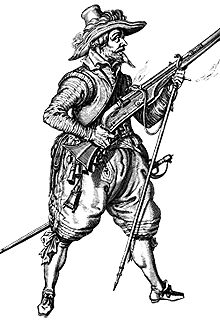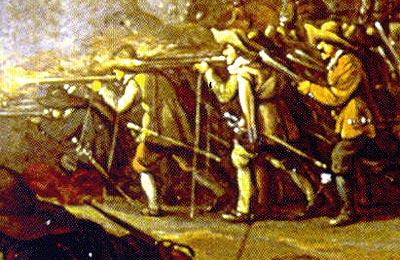| Musket |
Only four years after its debut, the musket convincingly demonstrated its penetrating power at the Battle of Pavia, 1525. There, Spanish musketeers sometimes brought down two men with a single shot – there were even reports of two horses felled by one musket ball. Under 50 meters, shot-proof armor was no longer shot proof, a leather jerkin did as much good as that armor. A hand-held weapon of such stopping power was soon sought after by army commanders throughout Europe.
But it was a cumbersome weapon – so much so that using it required a “unipod” rest. Going into the 17th century, the musket weighed as much as 25 pounds and stretched nearly two meters long. In his ‘Souldier’s Accidence,’ 1625, author Gervase Markham mentioned that only “the squarest and broadest (men) will be fit to carry musquets…” And they were paid more than those carrying lighter hand-held firearms such as the arquebus and caliver.

Shortly before 1631, due in large part to improved forging techniques, the musket began to be made with smaller outside diameters – with shorter barrels – matched by less wood in the stock, which lightened it to around 15 pounds. The rest became optional. All this without sacrificing the musket’s respected punch.
Keen to have the latest military technology, King Gustavus Adolphus introduced those lightened muskets into his army and many were in the hands of his musketeers on the eve of this battle.
King Gustavus Adolphus also debuted his concept of effective fire for his muskets: the salvé.
Count Maurits Van Nassau with two of his cousins laid the groundwork for coordinated fire 34 years earlier by devising a 10-deep file of hand gunners fire by rotation; after the lead man fired, he walked back to the rear of his file to reload. By the time he’d completed his reloading procedures, he was back at the front of the line. Several files doing this together could roll out one set of shots after another. This was the firing method for the Imperial-Leaguist at Breitenfeld.
 |
The king improved on this by having three ranks of musketeers fire simultaneously, making a heart-trembling roar – as well as smiting his enemy with a devastating number of lead balls, felling many at once to the psychological shock for the survivors. Sir James Taylor witnessed what this technique did to “pour as much lead into your enemies bosom at one time…and thereby you do them more mischief… for one long and continuated crack of thunder is more terrible and dreadful to mortals than ten interrupted and several ones.” Those three ranks would be immediately followed by the other three ranks of his six-deep files. Raimondo Count Montecuccolli observed: "It is quite certain that when a squadron sees nine or ten men felled from its front rank, the remainder thinks only of its own fate."
The three ranks would be arranged with the first rank kneeling, the second rank crouching over those kneeling and the third rank standing tall behind the crouching rank to result in three tiers of musket barrels pointing at the enemy. To get this right, as well as to reload single-shot muzzle loaders with black powder from little wooden vials, required focused training – and the king made sure his musketeers received that training until the motions became routine.
An older battle formation had soldiers in thick blocks, tercios – Tilly’s tercios were thought to have been generally 50 wide by 30 deep (but there is evidence to indicate a thinner formation). King Gustavus Adolphus devised what was to be termed the 'Swedish Brigade' to enable the salvé method to be the most effective, by having a unit of troops spread across in a broad line. The Swedish Brigade was more maneuverable and responsive to changing conditions than the tercio. The salvé became a model for armies until the widespread utilization of the rifle with its long-range accuracy in the period of the American Civil War.